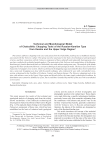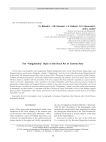Paleoenvironment, the stone age. Рубрика в журнале - Archaeology, Ethnology & Anthropology of Eurasia

Статья
An especially noteworthy part of the Firsovo archaeological area is a group of early burials at the fl at-grave cemeteries Novoaltaisk-Razvilka, Firsovo XI, and Firsovo XIV. Nine radiocarbon dates have been generated for those cemeteries at various laboratories: two by the liquid-scintillation (LSC) method and seven using the accelerator mass spectrometry (AMS) method. The dates were calibrated using OxCal version 3.10 software. Dates for the Chalcolithic Bolshoy Mys culture burials at Novoaltaisk-Razvilka and Tuzovskiye Bugry-1 burial 7 match the previously suggested ones (around 3000 BC). Certain Neolithic burials in the Altai differ from others in the position of the bodies (fl exed on the side). They were dated to the late 5th to the early 4th millennia BC by the AMS method. Burials belonging to the “cultural core” of Firsovo XI, then, fall within the Early Neolithic (68 % interval, 5710–5460 BC; 95 % interval, 5740–5360 BC). The date 9106 ± 80 BP (GV-02889), obtained for Firsovo XI burial 18, may be somewhat accurate, pointing to the Final Mesolithic or Early Neolithic. Both the date and the cultural characteristics of this burial (sitting position, abundant ocher) are accompanied by the craniometric distinctness of the male cranium (huge total size).
Бесплатно

Статья научная
This article presents the results of a study of ceramics associated with the Valdivia and San Pedro complexes at the Real Alto site, southwestern Ecuador. The test sample, studied in 2022, includes fragments of vessels from two morphological and functional groups, relating to the first two phases of the Valdivia culture (bowls and pots) and those representing the San Pedro complex (vessels with necks and a bowl). A comparative analysis was based on identified technological indicators marking various stages of pottery manufacture. Certain differences are seen in the composition of paste and in the hand-shaping of the vessels. Significant differences were revealed in surface treatment and decoration. This is evidenced by the use of colored and plain coating, high-quality solid or matte striped polishing, and complexity of decoration. Distinctive features of firing include the use of different kilns and various atmospheric modes. Parallels include broadly similar firing temperatures. The technological difference between the two morphological and functional groups of the Valdivia complex is that bowls were manufactured with more complex and labor-consuming techniques, whereas pots are technologically somewhat similar to those from San Pedro. Radiocarbon dates (4640–4450 BP) suggest that the two traditions coexisted. Differences may reflect their cultural distinctness.
Бесплатно

Rock Art of the Ana Zaga Cave Shelter in the Archaeological Landscape of Gobustan, Azerbaijan
Статья научная
The Agisoft and 3D Studio Max software was used to study the petroglyphs of the Ana Zaga rock shelter, the largest in Gobustan. Stylistic features typical of various periods are described, and radiocarbon estimates for various cultural layers are given. Chronological stages in the evolution of rock art are defined. On the basis of geological data concerning transgressions and regressions of the Caspian Sea, the date of the first human settlement of the Ana Zaga shelter is estimated. The species composition of extinct faunas represented in rock art is assessed. It is concluded that in the Neolithic and Chalcolithic, following the rise of the sea level, the rock shelter became the principal habitat. In the Bronze Age, after the sea level had fallen, the middle and lower terraces became suitable for living. As new landscapes were settled, the themes of petroglyphs changed.
Бесплатно

Sanctuary with “Kalguty” style images in northwestern Mongolia (preliminary data)
Статья научная
This article presents the first results of a detailed study of a key rock art site with the earliest petroglyphs in the Mongolian Altai—Baga-Oigur-5 (Right Bank). Basic data on its location, the surrounding environment, etc. are provided. The main groups of petroglyphs are characterized and attributed. The most numerous group, that of the "Kalguty" style, is examined in detail. This style was previously attributed by the current authors to the Final Upper Paleolithic. Bronze Age and medieval petroglyphs are also present at the site. The most informative panels show single horses, bulls, sheep, and deer rendered in the "Kalguty" style, as well as compositions including these animals. Among the earliest local rock art, for the first time, a nonfigurative sign has been found, resembling a grid, connected with the figure of a horse in a manner that is typical of prehistoric art. The analysis of a multilayered composition—one of the most important—confirms the hypothesis that "Kalguty" style petroglyphs predate the Bronze Age. The unusual natural context of Baga-Oigur-5 (Right Bank) is addressed in detail: a restricted area with available flat rock surfaces standing out against a background landscape with convex boulders. The arrangement of rock carvings within the site is unusual: animal figures on various surfaces combine in a nearly compositional manner. A tentative conclusion is made that the site was a sanctuary.
Бесплатно

Shulbinka Paleolithic site, Eastern Kazakhstan, revisited
Статья
This study revises the cultural and chronological attribution of the Shulbinka site, Eastern Kazakhstan, with reference to recent ideas of the Early Upper Paleolithic in northern Central Asia, including new sites dating to that stage (Tolbor-21, Ushbulak, etc.) and a representative series of absolute dates relevant to the site’s chronology. We describe the discovery of the site and principal fi ndings of excavations carried out more than 20 years ago, focusing on the comprehensive analysis of artifacts from Shulbinka, conducted in 2019. We demonstrate that the estimated age and the cultural attribution of the site disagree with earlier interpretations. Earlier claims about the presence of Levallois and Mousterian components in the primary reduction system appear poorly supported. The idea that artifacts from the site resemble those of the Early Upper Paleolithic is subjected to a critical inquiry. As it turns out, the closest parallels to this assemblage are found among the Final Upper Paleolithic industries of southern and central Siberia. Important traits include the combination of large cores for making fl akes, blades with edge-faceted and wedge-shaped microcores, and the predominance of end-scrapers and chisel-like tools. Few parallels can be found with industries of different cultural and chronological periods. Based on these analyses, we conclude that the site of Shulbinka dates to the Final Paleolithic. The absence of Final Middle Paleolithic or Early Upper Paleolithic markers makes the site irrelevant to debates around the origin of the Upper Paleolithic in the region.
Бесплатно

Статья научная
We describe 27 parallel, narrow-faced, and burin-cores for small blades and bladelets from Kulbulak layer 23, Western Tien Shan, excavated in 2016 and 2017. In terms of typology, flat-faced (longitudinal and transverse), prismatic (carinated, subconical, and subcylindrical), and narrow-faced cores (including burin[1]cores) were identified. Scar pattern analysis suggests that regardless of the typological affiliation of cores, a uniform technological scheme was used—staggered sequence of blanks. This Middle Paleolithic non-prismatic pattern probably indicates the initial steps in the formation of a technology that would subsequently influence the Middle Paleolithic blade industries in western Central Asia and become one of the sources for the regional Upper Paleolithic in the second half of MIS 3. It is concluded that small blade technology emerged within Middle Paleolithic industries of western Central Asia at the turn of MIS 7 and 6. In the Obi-Rakhmat industry (MIS 5a), this technology is represented in its fully developed form.
Бесплатно
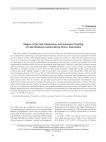
Stages in the late Pleistocene and Holocene peopling of lake Bolshoye Ushkovskoye shore, Kamchatka
Статья обзорная
Бесплатно
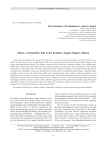
Stoilo—A Paleolithic Site in the Southern Angara Region, Siberia
Статья научная
On the basis of findings of the autumn 2021 field season, we present the first information on the Paleolithic site of Stoilo (Usolsky District of the Irkutsk Region). The site, located on the left bank of the Angara River, belongs to the Belaya geoarchaeological region. The complex is enclosed in pre-Holocene sediments relating to the residual gruspebble crust, which overlies the soliflucion layer tentatively dating to the Late Karga–Early Sartan period. The analysis of the lithics, mostly made on siliceous rocks, indicates prismatic reduction resulting in small blades. The toolkit consists of small pieces, including various types of spurred tools, burins, knives on naturally backed blades, retouched blades and flakes with use-wear, and a heavy-duty pebble tool. A specific feature of the complex is that most artifacts reveal superficial traces of minor corrasion—a weak surface gloss. This and the fact that the material relates to the gruspebble layer might be viewed as formal indicators of the “Makarovo Horizon”. However, the totality of typological and technological features and the structure of the sediments suggest that Stoilo represents the middle stage of the Upper Paleolithic, dating to the Early Sartan stage. To confirm this assumption, further excavations are needed in order to augment the collection and obtain more environmental data.
Бесплатно

Stone Age Ivory Points from the Arctic Zone of Northeast Asia
Статья научная
We give a technological and typological description of two well-preserved points (one fragmented rod-shaped, the other double-slotted), made of mammoth ivory and found in the Ust-Yansky District of Sakha-Yakutia in 2016. Traces evidencing various stages of manufacture are described in detail. A succession of technological operations is reconstructed, from the preparation of preforms and further processing by planing and abrasion to final polishing. Spall negatives on artifacts are interpreted as post-depositional damage that could have occurred from the effect of cryogenic processes in sediments. The slotted specimen is decorated with five finely engraved arrows. The discovery context and the morphology of the rod-shaped specimen are similar to those of ivory points from the Yana sites, whereas the slotted one resembles those from Zhokhovo and other Northeast Asian sites of the same age. Radiocarbon analysis of the points supports these findings. The following conclusions are reached: the rod-shaped point dates to MIS 3, and the slotted one, to MIS 2; such points evidence an elaborate technology of ivory processing during the Late Pleistocene and Early Holocene in the high latitudes of Northeast Asia and an adaptation to the scarcity of lithic raw material in the region.
Бесплатно

Technological development of the Neolithic pottery at Goytepe (West Azerbaijan)
Статья обзорная
Бесплатно

Статья научная
Cyclic variations of δ18O along the growth line of M2 and M3 molars provide information about the seasonality of enamel formation and thereby about reproductive seasonality in animals, taking into account the time of tooth eruption and full enamel maturation. Determination of birth seasonality of small ruminants is relevant to the reconstruction of pastoralist strategies. Two peaks of reproductive activity per year are one of the most reliable indicators of human control of the small ruminants. As part of this work, for the first time in Russia, a method of sample preparation and analysis of oxygen isotope ratios in the tooth enamel of small ruminants is proposed. Traditionally, breeding seasonality was evaluated by the isotopic analysis of carbonates, the content of which in dental enamel is only 4 %. According to a new approach, oxygen from a sample is converted to gaseous CO by the interaction of enamel with carbon in a helium flow under 1300 °С, enabling one to measure δ18O in all components of the dental enamel, including phosphates, which make up 90 % of enamel mass and are resistant to diagenesis. In this study, four sample preparation protocols depending on the degree of preservation of teeth and their age were tested: (A) cleaning and sampling of enamel, (B) treatment by H2O2, (C) treatment by NaOCl and CH3COOH, and (D) extraction of Ag3PO4. Results show that for assessing seasonality breeding, it suffices to evaluate the lowest and the highest δ18O along the tooth growth line. If the preservation of sample is good, minimal chemical treatment is enough to observe these extremes.
Бесплатно
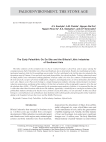
The Early Paleolithic Age site and the bifacial lithic industries of Southeast Asia
Статья
Бесплатно

The Russian Archaeological Project in South America: Principal Findings and Prospects
Статья научная
This study outlines the findings of field and laboratory studies by the first Russian archaeological expedition to South America in 2014–2015 and 2017–2018 in collaboration with colleagues from Ecuador and Japan. The project focused on sites of the Archaic (10.8–6.6 ka BP) and Early Formative period (5.5–3.5 ka BP) in the coastal zone of Santa Elena Province, Ecuador. Excavations at Real Alto (Valdivia culture) and Loma Alto (Las Vegas culture) yielded representative archaeological, anthropological, and faunal samples and a large series of AMS dates, providing a basis for a number of novel proposals regarding the chronology and periodization of cultures, their origin, and early pottery-production in South America. Specifically, we have demonstrated that at the very beginning of the Formative period, two early ceramic traditions coexisted—Valdivia and “San Pedro”. We have demonstrated the peculiarity of the “Tropical package” in the stone toolkit, and traced the previously unknown features of the funerary rites of the Las Vegas and Valdivia cultures. Radiocarbon analysis helped to correct the chronology of the late stage of the pre-ceramic Las Vegas culture (8.0–4.8 ka BP) and to estimate the tentative date of the earliest pottery manufacture at 4.8–4.7 ka BP. In conclusion, we outline the top priorities and prospects of Russian archaeological studies on the Pacific coast of South America, underscoring the importance of international cooperation.
Бесплатно
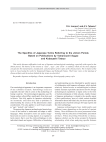
Статья научная
This article discusses difficulties in the use of Japanese archaeological terminology, especially with regard to the Jōmon period. The history of the notions of “style”, “type”, and “form” is outlined, which are the most adequate concepts for the interpretation, classification, and description of new styles of the Jōmon pottery. The evolution of the terms is traced using the works by Yamanouchi Sugao and Kobayashi Tatsuo. Their basic views on the typology of Jōmon artifacts and the notions behind the key terms are described.
Бесплатно



